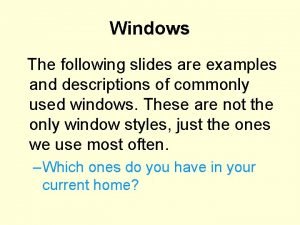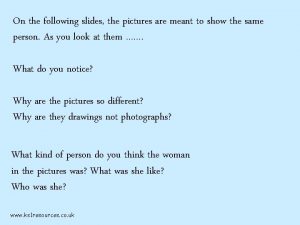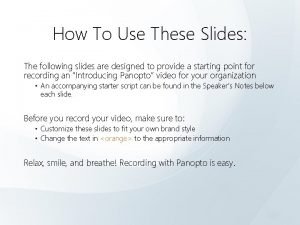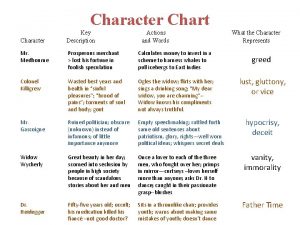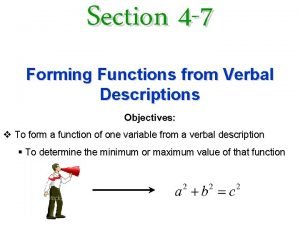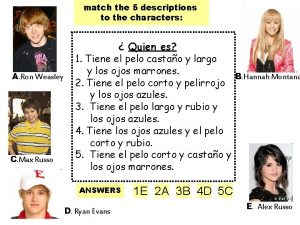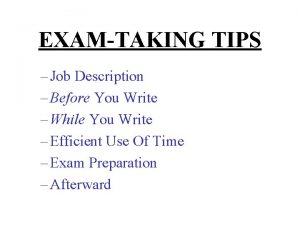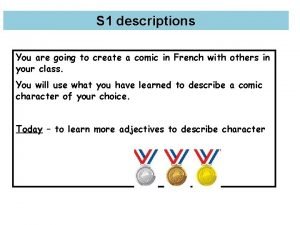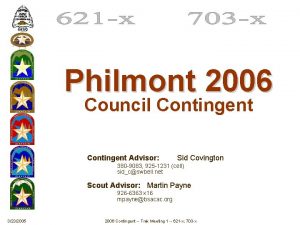Windows The following slides are examples and descriptions














































































- Slides: 78

Windows The following slides are examples and descriptions of commonly used windows. These are not the only window styles, just the ones we use most often. – Which ones do you have in your current home?

Awning Window Glass pane that pushes out from the bottom, so the top of the glass is fixed in place.

Bay Window window projects out beyond the plane of the wall, floor to ceiling, three sides

Bow Window Similar to a bay window, but it curves with more sashes and less angularity

Casement • Windows that open out and some have screens • Sashes that crank open

Dormer Window A small window projecting from the house in an alcove-like extension of the room, commonly used in attics to make home appear larger and to provide light.

Double Hung Window Stacked windows, open with one panel sliding up or beside another panel

Fixed Pane Windows This type of window has no moving parts.

French Doors These window/doors come in pairs. Either one or both can open into another room or outside to a patio/porch.

Garden or Oriel Windows come in a variety of shapes and sizes. Some have panes that open out or slide open, but does not touch the floor.

Glass Blocks Allow daylight without sacrificing privacy, available in a broad range of styles and options

Hopper Window Opens from the top and the bottom is fixed in place. This window operates the opposite of the Awning window.

Jalousie These windows are installed in breezy areas where cross- ventilation is a plus! They open and close using a crank mechanism.

Light tubes Ceiling port Non-operable windows that introduce light into the room.

Palladian Window created by Mr. Palladian. The top of the window has a semi circular fixed series of window panes.

Picture Window A window designed to frame an outside view that is usually one or several fixed pane(s)

Roof Lantern Window Skylight structure in the form of a lantern, used to provide light and ornamentation.

Ranch or Strip Windows Most often a wide window set high off the floor. It usually has sliding sashes. They often require special consideration when decorating to make them attractive.

Sidelights Small narrow fixed pane windows used to frame a door

Skylights Non-operable windows that introduce light into the room.

Sliding Glass Doors Often set into a regular wall, one panel slides to form doorway. Some glass doors will have a screen door as well. Privacy can be an issue!

Stained Glass Window Created from colored, frosted or beveled glass used in both the interior and exterior of buildings and homes.

Windowscape Composed of various shapes of windows on one wall

Parts of a Window Vertical jamb---- glass apron

Parts of a Window Muntin- single strip of wood that frames a single pane of glass into smaller pieces Mullion – strips that separate smaller pieces of glass in a larger window Frame – stationary framework that encloses the sash, sill and sides of the window

• Sash – the framework that surrounds the glass within the window frame, it may be fixed or operable. • Sill – the shelf at the base of the window • Jamb – the sides that form a window frame

• Apron – the interior window piece just below the sill • Grille - a removable decorative grating that makes an expanse of glass look as though it is made up of many smaller panes

Low-E Windows • Highly efficient Low-E windows have a coating that reduces the UV rays. This creates an energy loss by as much as 30 – 50%. As a result, your home will stay cooler in the summer and warmer in the winter. They also help protect your homes furnishings from UV light that can cause fabrics to fade.


Dual Pane Windows • 2 pieces of glass ½ inch apart. The gap is filled with inert gas like argon, krypton or carbon dioxide. This space acts as thermal barrier so it transfers less heat in or out of the home.

WINDOW TREATMENTS

How to measure a window • How to measure the window – Use steel tape measure for accuracy – Measure accurately top, middle and bottom, add 1/8 inch – Measure height and record, than width and record

– Measure each window separately, never assume they are the same – Decide whether the treatment will be hung on the inside or the outside of the window. Check the manufacturer’s information for clearance information.

Factors for choosing a window treatment –Personal taste –Money –Upkeep of treatment --Custom-made, ready-made or homemade

– Design details - window treatments have a tremendous impact on the room, either formal or informal mood • Type of window helps determine the treatment • Scale and proportion of covering • Placement of window (direction of exposure) • Color scheme of room

• Control of the home environment –Light: blocking or filtering –Noise: blocking or filtering –Insulation from cold or heat –Privacy

Window Treatment Hardware – Will it be seen or unseen? – Will it be on a traverse rod or stationary rod? – Will it be made of wood or metal? – Will the rod have endcaps or finials? – Will there be tiebacks or hold backs

• Hello students!! This slide and the next 3 slides are not in your notes. The photos are included for you to have a visual so that you will understand what an endcap is and how it is different than a finial, etc.

Traverse Curtain Rod • Curtains move left and right by pulling a cord up or down • Stationary rod curtains do not move

Endcaps and Finials

Tiebacks (fabric) and Holdbacks are used to hold curtains back permanently

Formal draperies go to the floor

Romantic draperies and curtains puddle onto the floor

Fabric (curtains) that stops at the sill or apron of a window is informal.

Curtains are unlined, lightweight, sheet to medium weight, informal.

Sheers - better to be full in appearance, can remain in place or be drawn back

Café -½ window is covered, often used the kitchen or bath windows

A Sash curtain is flat and anchored to the top and bottom, often used on a door.

Tie Back Curtains The curtain is pulled back permanently.

Priscilla curtains - tieback with lots of ruffles on the edges

Tabtop curtains - has tabs that hold the curtain onto the rod

Curtain Hardware

Tension rods - fits in the window and is held in place by tension of an interior spring

• Sash rods are anchored by nails to the door/wall • Extension rods are attached to the wall, comes out 1/2”, 1”, or 1 ½” from the wall

Draperies are heavier fabrics, often lined for extra protection from light, sound and temperature. Most draperies are pinch pleated and hang from a traverse rod. – Can be stationary panels – Focuses attention on the window

Draperies cont. d –Can be used to change the apparent shape, size or placement of a window, or even suggest an non-existent window –Dry-cleanable, needs vacuuming often

Drapery Toppers are often decorative, used to hide hardware, cover and undesirable window shape and give the illusion of height

Cornices are constructed of wood and covered with fabric, painted, stained or padded and covered with fabric

Valences are short lengths of fabrics placed across the top of the window

Pelmets are architecturally stiffened fabric scarves used in Palladian windows

Swags are fabrics draped gracefully across windows attached on both sides; Jabots are fabrics that drape gracefully down the sides in folds

Blinds • Blinds are evenly spaced slates that can be manipulated with a cord, wand, by touch or with a remote control; the whole blind can be drawn up/down or over.

Horizontal blinds

Venetian blinds

Plantation blinds are white wood slats, 1” in width

Mini blinds have ½” metal or plastic slats; Micro-mini blinds have less than ½ inch wide slats

Vertical Blinds – 3 ½” slats run perpendicular to the ground, often used to cover a sliding glass door

Roller shades– top mount, sometimes: fabric covered, fringed, room darkening, light filtering, and/or heat reflective

Roman Shades lie flat until raised/drawn up, then it creates a series of horizontal folds

Balloon shades are similar to Roman, but create poufs when drawn up

Waterfall shades are similar to Roman but has softer folds

Pleated single sheet blinds are permanently creased fabric

Cellular blinds or shades are double honey-combed, great insulators

Cellular blinds or shades • • • top hung bottom hung top&bottom hung power rise fabric outsides with moveable slats inside

Shutters are fixed to the wall or inside of the window, wooden, semi-moveable slats, hinged to be bi-fold

Alternative window treatments – Silk vines draped around the window – Fishnets across the top of the window – Moveable shutters that are not attached to the wall – Lace tablecloths, bed sheets or blankets hung as curtains

Stained, frosted or etched glass

Glass blocks
 Antigentest åre
Antigentest åre Match the word with the definition mug burglary
Match the word with the definition mug burglary A small child slides down the four frictionless slides
A small child slides down the four frictionless slides Ball a has half the mass and eight times
Ball a has half the mass and eight times Match examples 1-3 with descriptions a-c
Match examples 1-3 with descriptions a-c What does concrete detail mean
What does concrete detail mean Fundamental sampling distributions and data descriptions
Fundamental sampling distributions and data descriptions Sample and population example
Sample and population example Listen and complete the descriptions
Listen and complete the descriptions Read the descriptions and match
Read the descriptions and match Fundamental sampling distributions and data descriptions
Fundamental sampling distributions and data descriptions Windows live movie maker transitions
Windows live movie maker transitions Windows media player 9
Windows media player 9 Windows live mail windows 8
Windows live mail windows 8 Windows driver kit windows 7
Windows driver kit windows 7 Herramientas de movie maker
Herramientas de movie maker Video player for pc
Video player for pc Windows identity foundation windows 10
Windows identity foundation windows 10 Windws update
Windws update Setup windows xp virtual machine
Setup windows xp virtual machine Windows mobile center windows 10
Windows mobile center windows 10 Windows movie maker 2012 download
Windows movie maker 2012 download Ipseq
Ipseq Windows 7 xp mode
Windows 7 xp mode In the following slides
In the following slides Arkive
Arkive In the following slides
In the following slides In the following slides
In the following slides Following slides
Following slides Slidetodoc.com
Slidetodoc.com In the following slides
In the following slides True colors assessment
True colors assessment Describe the ambiguity in nick's descriptions of gatsby
Describe the ambiguity in nick's descriptions of gatsby Love languages adults
Love languages adults Tapsr
Tapsr Phase changes in matter
Phase changes in matter Nyseslat levels
Nyseslat levels Piggy lord of the flies
Piggy lord of the flies Maria mathew
Maria mathew Basc-3 sample report
Basc-3 sample report Como hacer una descripcion personal
Como hacer una descripcion personal Programer job description
Programer job description Ctopp subtests
Ctopp subtests Use case description document
Use case description document Qualitative and quantitative data analysis
Qualitative and quantitative data analysis Mcmiiii
Mcmiiii Movie set hierarchy
Movie set hierarchy Pengertian public figure
Pengertian public figure Character description chart
Character description chart Woodcock johnson iv bell curve
Woodcock johnson iv bell curve Competency based job descriptions
Competency based job descriptions Turtle wexler character traits
Turtle wexler character traits The scarlet letter characters
The scarlet letter characters Forming functions from verbal descriptions
Forming functions from verbal descriptions Match the description to the character
Match the description to the character Loan officer job description
Loan officer job description Ipsa job descriptions
Ipsa job descriptions Dinosaur descriptions
Dinosaur descriptions Technical object description example
Technical object description example Fictional character descriptions
Fictional character descriptions Ubc job descriptions
Ubc job descriptions Oars acer pat
Oars acer pat Workday roles and responsibilities
Workday roles and responsibilities King enk
King enk Wound descriptions with pictures
Wound descriptions with pictures Philmont scout ranch map
Philmont scout ranch map Hát kết hợp bộ gõ cơ thể
Hát kết hợp bộ gõ cơ thể Frameset trong html5
Frameset trong html5 Bổ thể
Bổ thể Tỉ lệ cơ thể trẻ em
Tỉ lệ cơ thể trẻ em Voi kéo gỗ như thế nào
Voi kéo gỗ như thế nào Tư thế worm breton là gì
Tư thế worm breton là gì Hát lên người ơi alleluia
Hát lên người ơi alleluia Các môn thể thao bắt đầu bằng từ đua
Các môn thể thao bắt đầu bằng từ đua Thế nào là hệ số cao nhất
Thế nào là hệ số cao nhất Các châu lục và đại dương trên thế giới
Các châu lục và đại dương trên thế giới Công thức tiính động năng
Công thức tiính động năng Trời xanh đây là của chúng ta thể thơ
Trời xanh đây là của chúng ta thể thơ Mật thư anh em như thể tay chân
Mật thư anh em như thể tay chân
























